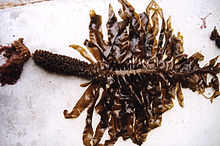| Wakame | |
|---|---|

| |
| mature sporophyte | |
| Scientific classification | |
| Domain: | Eukaryota |
| Clade: | Diaphoretickes |
| Clade: | SAR |
| Clade: | Stramenopiles |
| Phylum: | Gyrista |
| Subphylum: | Ochrophytina |
| Class: | Phaeophyceae |
| Order: | Laminariales |
| Family: | Alariaceae |
| Genus: | Undaria |
| Species: | U. pinnatifida
|
| Binomial name | |
| Undaria pinnatifida (Harvey) Suringar, 1873
| |
| Nutritional value per 100 g (3.5 oz) | |||||||||||||||||||||||||||||||||||||||||||
|---|---|---|---|---|---|---|---|---|---|---|---|---|---|---|---|---|---|---|---|---|---|---|---|---|---|---|---|---|---|---|---|---|---|---|---|---|---|---|---|---|---|---|---|
| Energy | 188 kJ (45 kcal) | ||||||||||||||||||||||||||||||||||||||||||
9.14 g | |||||||||||||||||||||||||||||||||||||||||||
| Sugars | 0.65 g | ||||||||||||||||||||||||||||||||||||||||||
| Dietary fiber | 0.5 g | ||||||||||||||||||||||||||||||||||||||||||
0.64 g | |||||||||||||||||||||||||||||||||||||||||||
3.03 g | |||||||||||||||||||||||||||||||||||||||||||
| |||||||||||||||||||||||||||||||||||||||||||
| †Percentages estimated using US recommendations for adults,[1] except for potassium, which is estimated based on expert recommendation from the National Academies.[2] | |||||||||||||||||||||||||||||||||||||||||||
Wakame (Undaria pinnatifida) is a species of kelp native to cold, temperate coasts of the northwest Pacific Ocean. As an edible seaweed, it has a subtly sweet, but distinctive and strong flavour and satiny texture. It is most often served in soups and salads.
Wakame has long been collected for food in East Asia,[3] and sea farmers in Japan have cultivated wakame since the eighth century (Nara period).[4]
Although native to cold temperate coastal areas of Japan, Korea, China, and Russia,[5] it has established itself in temperate regions around the world, including New Zealand, the United States, Belgium,[6] France, Great Britain, Spain, Italy, Argentina, Australia and Mexico.[7][8] As of 2018[update], the Invasive Species Specialist Group has listed the species on its list of 100 worst globally invasive species.[9]
Wakame, as with all other kelps and brown algae, is plant-like in appearance, but is unrelated to true plants, being, instead, a photosynthetic, multicellular stramenopile protist of the SAR supergroup.[10]
- ^ United States Food and Drug Administration (2024). "Daily Value on the Nutrition and Supplement Facts Labels". FDA. Archived from the original on 2024-03-27. Retrieved 2024-03-28.
- ^ National Academies of Sciences, Engineering, and Medicine; Health and Medicine Division; Food and Nutrition Board; Committee to Review the Dietary Reference Intakes for Sodium and Potassium (2019). Oria, Maria; Harrison, Meghan; Stallings, Virginia A. (eds.). Dietary Reference Intakes for Sodium and Potassium. The National Academies Collection: Reports funded by National Institutes of Health. Washington, DC: National Academies Press (US). ISBN 978-0-309-48834-1. PMID 30844154. Archived from the original on 2024-05-09. Retrieved 2024-06-21.
- ^ "Undaria pinnatifida". Food and Agriculture Organization of the United Nations. Retrieved 11 March 2011.
- ^ Man'yōshū "比多潟の 磯のわかめの 立ち乱え 我をか待つなも 昨夜も今夜も" (Poetry on the theme of Wakame). Mouritsen, Ole G.; Rhatigan, Prannie; Pérez-Lloréns, José Lucas (2018). World cuisine of seaweeds: Science meets gastronomy. International Journal of Gastronomy and Food Science. Vol. 14. p. 57. doi:10.1016/j.ijgfs.2018.09.002. S2CID 134841112.
- ^ Epstein, Graham (7 October 2017). "Undaria pinnatifida: A case study to highlight challenges in marine invasion ecology and management". Ecology and Evolution. 7 (20): 8624–8642. Bibcode:2017EcoEv...7.8624E. doi:10.1002/ece3.3430. PMC 5648660. PMID 29075477.
- ^ Hillewaert, Hans. "Wakame - Undaria pinnatifida". Waarnemingen.be. Retrieved 6 March 2016.
- ^ Torres, A. R. I.; Gil, M. N. N.; Esteves, J. L. (2004). "Nutrient uptake rates by the alien alga Undaria pinnatifida (Phaeophyta) (Nuevo Gulf, Patagonia, Argentina) when exposed to diluted sewage effluent". Hydrobiologia. 520 (1–3): 1–6. doi:10.1023/B:HYDR.0000027686.63170.6c. hdl:11336/104326. S2CID 36999841.
- ^ James, K; Kibele, J; Shears, N. T. (2015). "Using satellite-derived sea surface temperature to predict the potential global range and phenology of the invasive kelp Undaria pinnatifida". Biological Invasions. 17 (12): 3393–3408. Bibcode:2015BiInv..17.3393J. doi:10.1007/s10530-015-0965-5. S2CID 13515136.
- ^ "Global Invasive Species Database". IUCN Species Survival Commission. Retrieved 2009-08-17.
- ^ Jo, Gayeon (2014). "Seaweed of Chujado Island". Korea National Biological Resources Center.